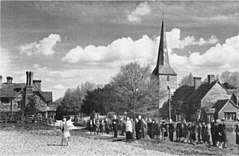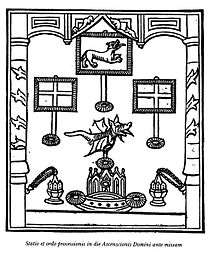Rogation days
Rogation days are days of prayer and fasting in Western Christianity. They are observed with processions and the Litany of the Saints. The so-called major rogation is held on 25 April;[1] the minor rogations are held on Monday to Wednesday preceding Ascension Thursday.[2] The word rogation comes from the Latin verb rogare, meaning "to ask", which reflects the beseeching of God for the appeasement of his anger and for protection from calamities.[3][4]
| Rogation days | |
|---|---|
 Blessing the Fields on Rogation Sunday at Hever, Kent in 1967 | |
| Observed by | Christians |
| Liturgical Color | Violet |
| Observances | Fasting and processions |
| Date | 25 April (Major) Monday, Tuesday, and Wednesday preceding Ascension Thursday (Minor) |
| 2019 date | 25 April; 27–29 May |
| 2020 date | 25 April; 18–20 May |
| 2021 date | 25 April; 10–12 May |
| 2022 date | 25 April; 23–25 May |
| Frequency | annual |
| Related to | Ascension Thursday |
Christian beginnings
The Christian major rogation replaced a pagan Roman procession known as Robigalia, at which a dog was sacrificed to propitiate Robigus, the deity of agricultural disease.[5][3] The practitioners observing Robigalia asked Robigus for protection of their crops from wheat rust.[3]
The minor Rogation days were introduced around AD 470 by Mamertus, bishop of Vienne, and eventually adopted elsewhere. Their observance was ordered by the Council of Orleans in 511, and though the practice was spreading in Gaul during the 7th century, it was not officially adopted into the Roman rite until the reign of Pope Leo III.[6]
The faithful typically observed the Rogation days by fasting and abstinence in preparation to celebrate the Ascension, and farmers often had their crops blessed by a priest at this time.[7] Violet vestments are worn at the rogation litany and its associated Mass, regardless of what colour is worn at the ordinary liturgies of the day.[3]
A common feature of Rogation days in former times was the ceremony of beating the bounds, in which a procession of parishioners, led by the minister, churchwarden, and choirboys, would proceed around the boundary of their parish and pray for its protection in the forthcoming year. This was also known as 'Gang-day', after the old English name for going or walking.[8] This was also a feature of the original Roman festival, when revellers would walk to a grove five miles from the city to perform their rites.[5]
In traditional Methodist usage, The Book of Worship for Church and Home (1965) provides the following as one of the prayers for Rogation days:[9]
O God, who hast placed us as thy children in a world thou hast created for us: Give us thankful hearts as we work and as we pray. We praise thee for the day of light and life, for the night which brings rest and sleep, and for the ordered course of nature, seedtime and harvest, which thou hast given us. We bless thee that thou hast given us the joy of children, the wisdom of old men. We thank thee for all holy and humble men of heart, for the love of God and man which shines forth in commonplace lives, and above all for the vision of thyself, in loneliness and in fellowship, in Sacrament and in prayer; for these and all other benefits we praise and glorify the name, now and for evermore. Amen.[9]
The reform of the Liturgical Calendar for Latin Roman Catholics in 1969 delegated the establishment of Rogation Days, along with Ember Days, to the episcopal conferences.[10] Their observance in the Latin Church subsequently declined, but the observance has revived somewhat since 1988 (when Pope John Paul II issued his decree Ecclesia Dei Adflicta) and especially since 2007 (when Pope Benedict XVI issued his motu proprio called Summorum Pontificum) when the use of older rites was encouraged.[11]
In Montier-en-Der, Rogation Day processions were said to be events when miracles occurred. Miracle books reported a blind woman being healed and the lame being able to walk.[12] In Germany it was traditional for the local schoolmaster, rather than priest, to lead the procession.[13]
In the British Isles

The Rogation Day ceremonies are thought to have arrived in the British Isles in the 7th century.
The oldest known Sarum text regarding Rogation Days is dated from around 1173 to 1220.[8] In it, celebrations in the south of England are described, in which processions were led by members of the congregation carrying banners which represented various biblical characters. At the head of the procession was the dragon, representing Pontius Pilate, which would be followed by a lion, representing Christ. After this there would be images of saints carried by the rest of the congregation.[14] Many torches were present at each procession, weighing between 42 lb (19 kg) and 27 lbs (12 kg), which were bought by the church and parishioners jointly.[15]
Sarum texts from the 13th and 15th centuries show that the dragon was eventually moved to the rear of the procession on the vigil of the Ascension, with the lion taking the place at the front. Illustrations of the procession from the early 16th century show that the arrangements had been changed yet again, this time also showing bearers of reliquaries and incense.[14]
During the reign of King Henry VIII, Rogation processions were used as a way to assist crop yields, with a notable number of the celebrations taking place in 1543 when there were prolonged rains. Even before religious sensibilities turned towards the puritanical, there were concerns about the lack of piety at such events.[16] Robert Herrick penned a piece to capture the mood of the celebrations before their repression:
Dearest, bury me
Under that Holy-oak, or Gospel Tree
Where (though thou see'st not) thou may'st think upon
Me, when you yearly go'st Procession
During the reign of King Edward VI, the Crown having taken much of the Church's holdings within the country, liturgical ceremonies were not officially condoned or recognised as an official part of worship. However, in the reign of Queen Elizabeth I the celebrations were explicitly mentioned in the royal reformation, allowing them to resume as public processions.[17]
Rogation processions continued in the post-Reformation Church of England much as they had before, and Anglican priests were encouraged to bring their congregations together for inter-parish processions. At specific intervals, clerics were to remind their congregations to be thankful for their harvests. Psalms 103 and 104 were sung, and people were reminded of the curses the Bible ascribed to those who violated agricultural boundaries. The processions were not mandatory, but were at the discretion of the local minister, and were also ascribed more importance when a public right of way needed to be protected from agricultural or other expansion.[17]
The marches would follow prescribed routes, with York and Coventry being unique in their following royal entries.[18] On other routes, altars were erected at certain locations where antiphons were sung.[19]
Any Roman Catholic imagery or icons were banned from the processions. The then Archdeacon of Essex, Grindal of London, besought the church explicitly to label the tradition as a perambulation of the parish boundaries (beating the bounds), further to distance it from Italian liturgy. In the book Second Tome of Homelys, a volume containing officially sanctioned homilies of the Elizabethan church, it was made clear that the English Rogation was to remember town and other communal boundaries in a social and historical context, with extra emphasis on the stability gained from lawful boundary lines.[17]
For years after Rogation Days were recognised, the manner in which they were observed in reality was very different from the official decree. While it was officially ordered that the entire congregation attend, bishops began urging their priests to invite only older and more pious men. This, they believed, would stop the drunken revelry in those dioceses where Protestantism had yet to take a firm hold. Royal Injunctions concerning the practice were reinterpreted to restrict and regulate participants of the festivities.[17]
In London, Rogation Days, just like Easter or Hocktide, were times when begging was "legitimate" for the period of celebration.[20]
The new, Protestant, version of Rogation days became such a fixture in church life that the tradition was even carried over to the Americas by British colonists in Jamaica, Barbados, and South Carolina.[21] Though not widely celebrated in the modern Church of England, the holiday is still observed in some areas.[11]
See also
Bibliography
- (in Italian) Vito Pallabazzer: Lingua e cultura ladina, Belluno 1985, p. 502 (about the rogation days in Ladin tradition)
References
- In the rare circumstance of either Easter Sunday or Easter Monday falling on 25 April, the major rogation is transferred to the Tuesday after Easter (cf. Code of Rubrics of 1960, no. 80); this will next occur in 2038.
- Reff, Daniel T. (2005). Plagues, Priests, and Demons: Sacred Narratives and the Rise of Christianity in the Old World and the New. Cambridge University Press. p. 100. ISBN 9781139442787.
- Dues, Greg (1993). Catholic Customs & Traditions: A Popular Guide. Twenty-Third Publications. pp. 39. ISBN 9780896225152.
Robigalia.
- Catholic Encyclopedia article
- Burriss, Eli Edward (1928). "Some Survivals of Magic in Roman Religion". The Classical Journal. The Classical Association of the Middle West and South. 24 (2): 112–123. JSTOR 3289524.
- Cook, Albert Stanburrough (1926). "Augustine's Journey from Rome to Richborough". Speculum. 1 (4): 375–397. doi:10.2307/2847160. JSTOR 2847160.
- Shepherd, John (1801). A critical and practical elucidation of the Book of common prayer, and administration of the sacraments, and other rites and ceremonies of the Church. Oxford University.
- Houseman, Michael (1998). "Painful Places: Ritual Encounters with One's Homelands" (PDF). The Journal of the Royal Anthropological Institute. 4 (3): 447–467. doi:10.2307/3034156. JSTOR 3034156.
- The Book of Worship for Church and Home: With Orders of Worship, Services for the Administration of the Sacraments and Other Aids to Worship According to the Usages of the Methodist Church. Methodist Publishing House. 1964. p. 122. Retrieved 25 March 2017.
- General Norms for the Liturgical Year and Calendar arts. 45–47.
- Melton, J. Gordon (2011-09-13). Religious Celebrations: An Encyclopedia of Holidays, Festivals, Solemn Observances, and Spiritual Commemorations. 1. p. 749. ISBN 9781598842050.
- Nugent, Patrick J. (2001). "Bodily Effluvia and Liturgical Interruption in Medieval Miracle Stories". History of Religions. 41 (1): 49–70. doi:10.1086/463659. JSTOR 3176498.
- Terbovich, Fr. John B. (1963). "Religious Folklore among the German-Russians in Ellis County, Kansas". Western Folklore. 22 (2): 79–88. doi:10.2307/1497873. JSTOR 1497873.
- Liszka, Thomas R. (2002). "The Dragon in the "South English Legendary": Judas, Pilate, and the "A(1)" Redaction". Modern Philology. 100 (1): 50–59. doi:10.1086/493149. JSTOR 1215582.
- Pearson, Charles Buchanan (1878). "Some Account of Ancient Churchwarden Accounts of St. Michael's, Bath". Transactions of the Royal Historical Society. 7: 309–329. doi:10.2307/3677891. JSTOR 3677891.
- Stilgoe, John R. (1976). "Jack·o'·lanterns to Surveyors: The Secularization of Landscape Boundaries". Environmental Review. Forest History Society and American Society for Environmental History. 1 (1): 14–16 and 18–30. JSTOR 3984295.
- Davenport, Edwin (1996). "Elizabethan England's Other Reformation of Manners". ELH. 63 (2): 255–278. doi:10.1353/elh.1996.0015. JSTOR 30030221.
- Reynolds, Roger E. (2000). "The Drama of Medieval Liturgical Processions". Revue de Musicologie. 86 (1): 127–142. doi:10.2307/947285. JSTOR 947285.
- Zika, Charles (1988). "Hosts, Processions and Pilgrimages: Controlling the Sacred in Fifteenth-Century Germany". Past & Present. 118 (118): 25–64. doi:10.1093/past/118.1.25. JSTOR 650830.
- Hitchcock, Tim (2005). "Begging on the Streets of Eighteenth‐Century London" (PDF). Journal of British Studies. 44 (3): 478–498. doi:10.1086/429704. hdl:2299/33. JSTOR 429704.
- Beasley, Nicholas M. (2007). "Ritual Time in British Plantation Colonies, 1650-1780". Church History. Cambridge University Press on behalf of the American Society of Church History. 76 (3): 541–568. JSTOR 27645033.
External links
- Rogation Days at liturgies.net
- Catholic Encyclopedia article
